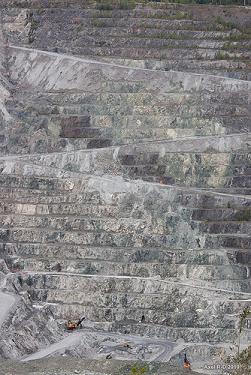Got change? Want change? Spare some and get some by becoming a member of rabble.ca today.
Long, long ago I was director of a small unit at Toronto City Hall dedicated to the vigorous promotion of public health. Among our findings was that Toronto’s drinking water supply was in potential danger of becoming unsafe and we recommended a major program to address this possibility.
Among Toronto’s political leaders at the time was Paul Godfrey, a Conservative who considered our concerns frivolous and time-wasting. Mr. Godfrey and I rarely agreed on anything, but as his entire life has demonstrated, he has always been among the smoothest operators this town has ever seen. I made our case and our team was fully armed for a long evidence-based debate, when Mr. Godfrey poured himself a drink of water and without a word chugalugged every last drop. The “debate” ended on the spot.
I am now proposing The Godfrey Test for asbestos. It’s as foolproof as drinking polluted water and living. It will apply to all those Canadians who have promoted the continuing mining and exporting of asbestos from Quebec to poorer countries. After much stalling, Quebec Premier Jean Charest has now agreed to loan $58-million to revive Canada’s last asbestos mine, the Jeffrey Mine in Asbestos, Quebec. Without this money, it would be the dead industry it should be.
For years, private investors had made it clear they wouldn’t touch the project without such public funding. At the same time, a huge anti-asbestos coalition has publicized the indisputable evidence that asbestos, even the chrysotile variety from the Jeffrey Mine, maims and kills those who come near it. Death is slow and agonizing. There is no credible health authority in the world that disagrees. The mainstream media in Quebec joined in strong opposition to the loan. Yet last week, late on the Friday before the Canada Day long weekend, a time when governments furtively leak news they want no one to know, the Charest government made the $58-million announcement that most of us were confident we would never hear.
Who knows what finally convinced the Premier to go ahead? Over the years, despite all the evidence, a tiny band of Canadians has spoken up for Quebec’s moribund asbestos industry. These notably include the Conservative government of Prime Minister Stephen Harper who for years funded the Chrysotile Institute, the asbestos lobby group, to the tune of $50,000 a year. The government also joined a handful of other nations at the Rotterdam Convention on hazardous substances to refuse to place asbestos on an international list of such unsafe substances.
During last year’s election campaign the PM made it a point to visit the riding held by Conservative MP Christian Paradis, in the heart of Quebec’s old asbestos mining region. Paradis has always been a promoter of re-opening the asbestos mines. After the election, the PM promoted Mr. Paradis to be Industry Minister.
In the private sector, a key player has long been Bernard Coulombe, a director of the Chrysotile Institute and owner of the bankrupt Jeffrey Mine. Mr. Coulombe insists that the kind of chrysotile asbestos he promotes does not cause mesothelioma, which is like asserting that filter-tipped cigarettes are harmless. When over a hundred prestigious scientists from 28 countries wrote to Premier Charest detailing why Quebec’s export of asbestos is indefensible, the publicly-funded Chrysotile Institute issued a press release calling these scientists “loufoque”, slang for wacko or nutty.
On May 12, 2011, Mr. Coulombe unexpectedly became a celebrity thanks to Jon Stewart’s The Daily Show. Interviewed by “correspondent” Aasif Mandvi, Mr. Coulombe turned out to be Mr. Mandvi’s perfect fall guy and the item was news across Canada.
So untypically outraged did Mr. Mandvi become that he dropped his ironic demeanour and lashed out at Mr. Coulombe for asbestos exports: “That’s really f**ked up,” he declared. “My family is over there [India]. That’s selling them things that are going to kill them.”
Now here comes The Godfrey Test. The Canadian Friends of Asbestos — all those who’ve been promoting asbestos exports to countries like India, Indonesia and Vietnam — must agree to welcome some form of asbestos into their lives to demonstrate exactly how safe it really is. Although asbestos is banned in 55 countries, including almost all developed ones, it is not banned in the U.S. and Canada. In the U.S., thanks to corporate lobbying, asbestos is still legally used in 3,000 different consumer products. Canadians mostly shuns asbestos use, but not entirely. We import $2.6-million worth of American-made asbestos brake pads each year and even children’s toys containing asbestos are permissible if, as the Canadian Environmental law Association points out, the child uses them in a reasonably safe manner.
So it’s easy to implement The Godfrey Test. Canadian Friends of Asbestos could equip their cars with asbestos brake pads. Asbestos-laden toys would be great Christmas or birthday gifts for their kids. Maybe they’d insulate their walls and roofs with it, as in the good old days.
A website would list Canada’s leading asbestos proponents so they could transparently demonstrate their confidence in the product. I’m confident that Kathleen Ruff, Canada’s most knowledgeable and formidable anti-asbestos activist, would gladly add to the few names I’ve mentioned above. The dishonour roll includes prominent politicians in the Parti Québécois and the Bloc Québécois, other Liberals and Conservatives, some private sector folks, and a surprising number of senior Quebec trade union officials for whom Solidarity Forever proves to be a strictly local value.
Experts believe that within a few year of their exposure to asbestos, all these people would know whether they they’re likely to suffer the “slow, hacking death” that Mr. Mandvi describes as the inescapable consequence of asbestos. Look, it was over 30 years ago that Paul Godfrey slugged down that sinister glass of water and he’s still going strong. Who knows? Maybe the Canadian Friends of Asbestos will have the same good luck.
This article was first published in the Globe and Mail.



